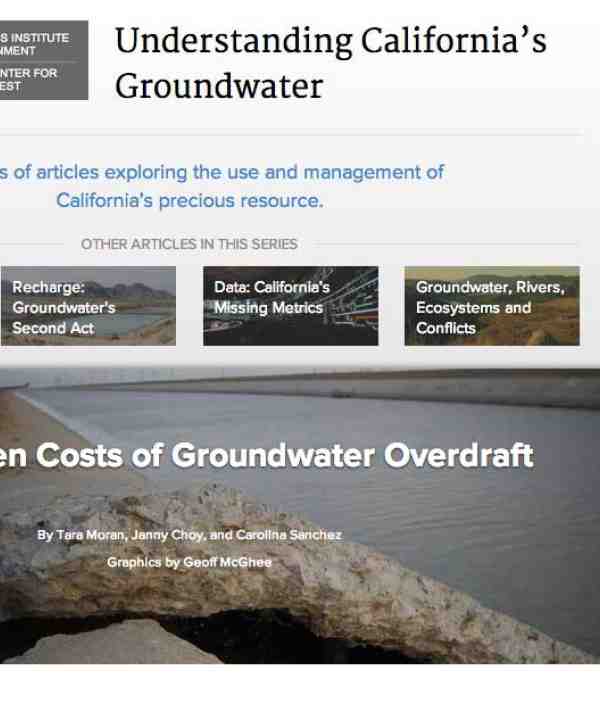September 11, 2014 | Water in the West | Insights
Above image: from the Water in the West series, "Understanding California's Groundwater"
It’s a big year for groundwater in California. For the first time in California history, the state is close to setting up a comprehensive framework for managing groundwater. A package of groundwater bills has been passed by the legislature and now awaits the governor’s signature. If signed, these bills will require and empower local governments and water management agencies to effectively manage their own groundwater basins. For the first time in California history, the state has established a pathway to sustainable groundwater management.
Groundwater is a critical water supply for California, especially in dry times. However, it has been chronically overdrafted in many basins throughout the state. Groundwater overdraft occurs when groundwater use exceeds recharge in an aquifer over the long-term, leading to declining groundwater elevations. An increasing number of people are seeing their wells dry up, leading to conflicts between neighbors. But there are many direct and indirect impacts of groundwater overdraft that affect not only groundwater users, but most other Californians in ways that may not be as obvious. The new bill focuses on this problem, and requires as an element of sustainable management that groundwater pumping not cause “significant and unreasonable” levels of overdraft over the long term.
Today, Water in the West is releasing a new article on groundwater overdraft in our recently published series Understanding California’s Groundwater. Entitled "the Hidden Cost of Groundwater Overdraft," this piece explores the impacts and costs of overdraft, including land subsidence and infrastructure damage, water quality degradation, the increased energy costs of groundwater pumping, and harm to groundwater-dependent ecosystems.
- Land subsidence can have serious consequences for infrastructure such as canals, levees, roads, bridges, building foundations, and pipelines. Groundwater-related land subsidence is an ongoing problem in many places throughout the state. Some areas in California’s Central Valley are dropping more than one foot a year.
- Energy demand and costs go up as groundwater elevations decline. These declines make it financially difficult for groundwater pumpers, tax the state’s electrical grid, and increase greenhouse gas emissions.
- Water quality degradation has been linked to groundwater overdraft, as it increases the concentration of pollutants in an aquifer. Seawater can be drawn into overpumped coastal aquifers, contaminating the basin and reducing freshwater supplies.
- Ecosystems that depend on groundwater are numerous. Many rivers, streams, wetlands, springs, lakes, and terrestrial vegetation – and the wildlife they support – rely on groundwater. Groundwater overdraft can place increased pressure on these ecosystems.
- Economic costs result from the many direct and indirect impacts of overdraft. Direct costs may stem from using more energy, drilling a deeper well or a new well, treating contaminated groundwater, or finding alternative water supplies. Many other costs of groundwater overdraft are externalities that are harder to quantify, including health problems linked to drinking contaminated groundwater or reductions in ecosystem services as rivers and springs dry up.
The impacts of groundwater overdraft are numerous, complex, costly, and have a reach that extends far beyond groundwater pumpers. The new groundwater legislation identifies many of these impacts -- water quality, saltwater intrusion, land subsidence, and “effects on beneficial uses of surface water” -- as “undesirable results” that must be avoided as a part of sustainable management.
Broad recognition of the myriad impacts of groundwater overdraft is a key factor in the push for groundwater legislation in California. Passage of the groundwater bills is a crucial start, but it is only the beginning of the long road ahead to sustainable groundwater management in the state.
Read more at Understanding California's Groundwater »


![[Woods Logo]](/sites/default/files/logos/footer-logo-woods.png)
![[Bill Lane Center Logo]](/sites/default/files/logos/footer-logo-billlane.png)